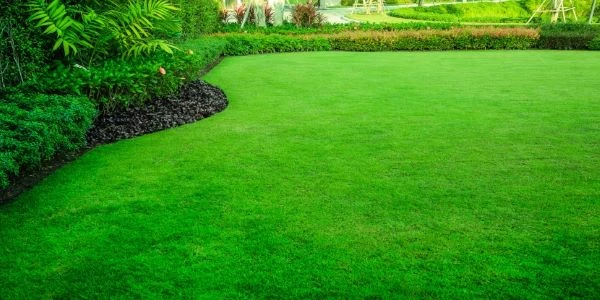How to Make Sure Your Lawn Stays Green
For many homeowners, keeping the lawn looking lush and green can be a challenge, especially during the late summer and early fall months. But believe it or not, a green lawn is possible to maintain for the entire year as long as you know the right steps to take. If you are tired of looking out at your front yard only to see spots of yellow and brown, this article will provide you with advice to help you keep your lawn looking green throughout the year.

Air It Out — Seasonal Aeration
Aerating your lawn is an essential and often overlooked step of lawn care maintenance. Providing your lawn with proper aeration will help keep your lawn in tip-top shape. The aeration process promotes a healthier, more durable root system, enables greater water and airflow to reach grass roots through the soil, and allows for better fertilization. Aeration also promotes new, stronger grass growth. Though the process can be a bit tedious and time-consuming, aeration should be done 1-2 times annually using a spike, core, or plug aerator to properly penetrate the soil at the right depth.
Fill In the Blanks — Overseeding
Depending on where you live, many homeowners will either seed or add sod to their lawn as needed. However, you may be unfamiliar with the process known as the overseeding method. Overseeding can help improve your lawns’ density by filling in bare spots or areas where grass growth is sporadic or non-existent. The best times to overseed your lawn are the fall and spring (preferably after aeration has taken place). Overseeding during fall and/or spring is best because the soil isn’t as stressed from foot traffic, drought, or pests. If you plan to use the overseeding method, make sure the area you overseed receives adequate irrigation to support the new growth.
Related Topic: How Short Should I Cut My Lawn?
Getting Testy — Test Soil Regularly
The health, stability, and potential of your lawn is highly dependent on the soil it’s growing in. Soil health is an important factor when it comes to lawn health, and one of the keys to a green, healthy-looking lawn. If your lawn isn’t looking particularly green or healthy, it could mean it’s not getting sufficient nutrients for it to thrive. If this is the case, it’s a good idea to have your soil tested regularly. Knowing your soil composition will give you some good insight into what your lawn needs and what your soil may be lacking. Once you understand the composition of your soil, you can adjust the nutrient level with a lawn supplement. This will help change the composition and address any underlying deficiencies.
When and How — Correct Fertilizer Usage
Dead or spotty patches on your lawn is never a pretty sight. When this happens, many homeowners take it upon themselves to fertilize their lawn. However, green lawn fertilizing versus fertilizing a lawn that is in distress is very different. Reviving dead spots on your lawn requires more than spreading some fertilizer around. In fact, spreading fertilizer on an unhealthy or dying lawn could worsen the problem. While using fertilizer isn’t necessarily wrong, applying it incorrectly can cause further damage to an already fragile lawn. There are a lot of different types of lawn fertilizers—nitrogen, nitrogen with inhibitors, phosphorus, micronutrient, and so on. Each of these fertilizers is designed for a specific purpose and must be applied based on specific conditions. So, depending on which type of fertilizer you use and when and how it’s applied, it can either help or harm your lawn.
Related Topic: Can Lawn Fertilizer Hurt My Pet?
Is Your Lawn Thirsty? Ensure Proper Irrigation
No lawn will survive without the correct amount of watering. Although some types of grass require less water than others, every lawn needs water. However, you can overwater your lawn. If grass gets too much water, it doesn't get oxygen, which will suffocate the roots and cause the grass to die. Too much water makes grass more susceptible to diseases.
So how much water is too much? When it comes to watering, there are a few things to consider. Do you live in a climate where the temperatures rise above 90 degrees daily? If so, you’ll need to schedule watering in the early morning hours when temperatures are not as high to lessen the effects of evaporation. If you live in a dry climate or one that only gets periodic rain, you’ll probably need to water 3-4 times a week depending on your grass type. If you live in a wetter climate or one that has an extended rainy season (over 3 months), you won’t have to water much, if at all.
It’s also best to water your lawn during the cooler hours of the day. Watering in the morning is ideal, since watering at night allows moisture to sit on the grass longer, which can encourage fungi growth. You should also check your irrigation system regularly and perform routine maintenance to ensure your system is doing a good job of watering your lawn and not the street or sidewalk.
Clean Up After Fido
We love our pets, but when your pet constantly uses your lawn as a bathroom it can really do a number on your grass. And because your pet can’t clean up after themselves, the task of removing pet poop from your lawn is going to fall on you. Leaving pet waste on your lawn is a sure-fire way to create those unsightly brown spots. Once the pet waste has been removed from the lawn, hosing down the area with some water will help dilute any remaining waste and minimize the effect on your grass.
Going Green — Hire a Pro
A beautifully landscaped home with a lush, green lawn adds value to the neighborhood and your home. But maintaining your property and keeping your grass lush and green does take time and knowledge. If you need help or don’t have the time to keep your lawn looking its best, The Grounds Guys can do the work for you.
Our team is trained and experienced to handle all of your landscaping and lawn maintenance, as well as the seasonal cleaning and mowing that will keep your lawn looking pristine the whole year through.
 Click to call
Click to call


